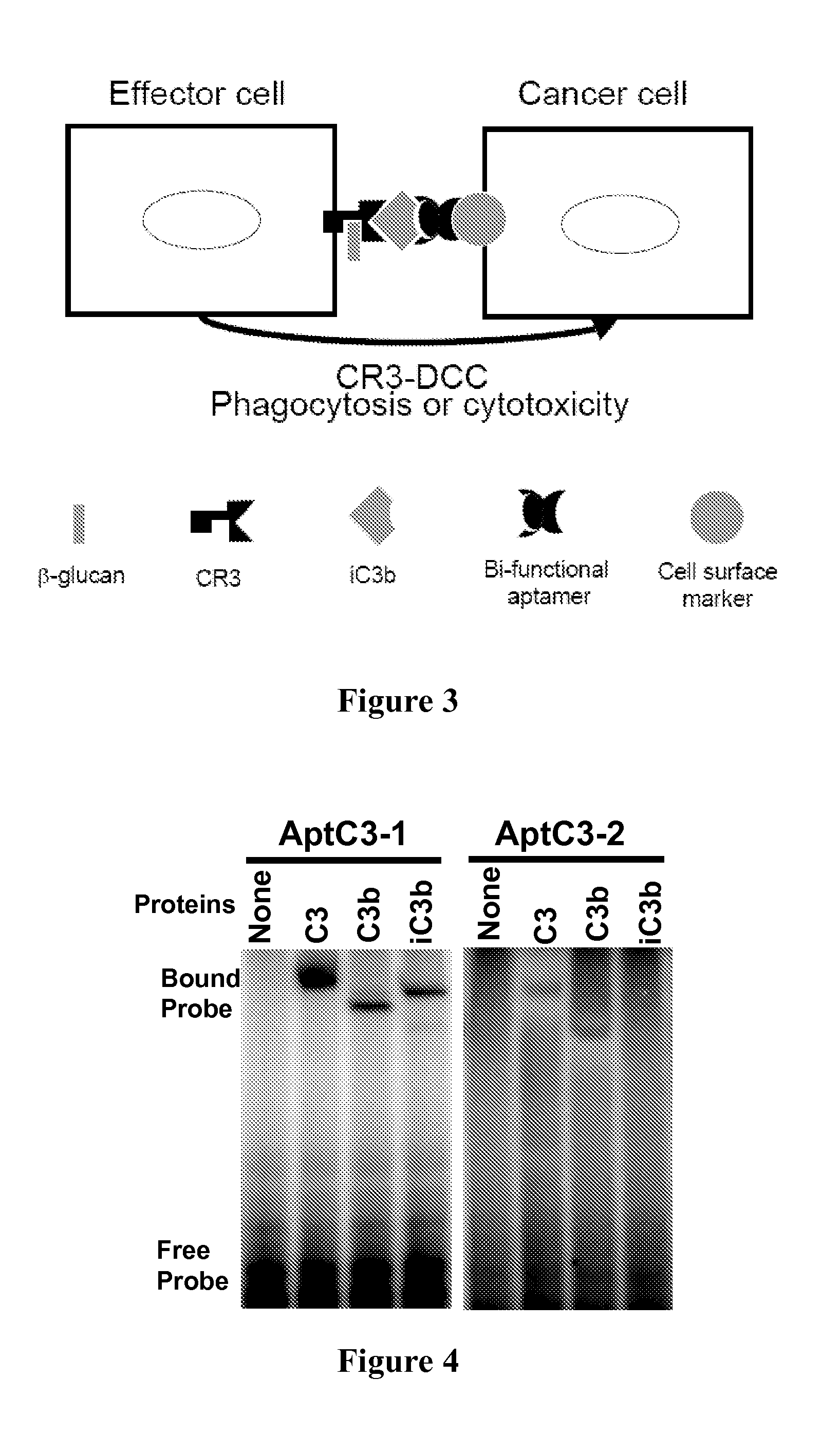Aptamer modulators of complement protein c3 and biologically active proteolytic products thereof
a technology of aptamer and complement protein, which is applied in the direction of energy modification materials, dna/rna fragmentation, dispersion delivery, etc., can solve the problems of complement system contributing to tissue damage, molecule damage, supramolecular assembly, etc., and achieves the effect of improving efficiency
- Summary
- Abstract
- Description
- Claims
- Application Information
AI Technical Summary
Benefits of technology
Problems solved by technology
Method used
Image
Examples
example 1
SELEX for C3
[0131]Iterative rounds of aptamer selection and amplification were performed using purified C3 protein as the target according to protocols described previously.
[0132]The aptamer candidate library was generated as single-stranded DNA on an automated solid-phase synthesizer by Integrated DNA Technologies, Inc. at 1 μmmole scale. This template strand, named Temp50, has the nucleotide sequence:
(SEQ ID NO: 1)5′-ACCGAGTCCAGAAGCTTGTAGTACT(N)50GCCTAGATGGCAGTTGAATTCTCCCTATAGTGA-3′,
where “(N)50”=A, G, T, C (1:1:1:1 expected, for 50 positions).
[0133]Double-stranded templates were generated by annealing to the Temp50 primer, named ForT7, followed by a bi-directional primer extension using the Taq DNA polymerase. The primer ForT7 contains the sequence of a T7 promoter for in vitro transcription, and has the nucleotide sequence:
(SEQ ID NO: 2)5′-GTAATACGACTCACTATAGGGAGAATTCAACTGCCATCTA-3′.
[0134]The double stranded templates resulting from the bi-directional primer extension can be sub...
example 2
Aptamer Binding Assays
[0141]The affinity of aptamers and their derivatives to C3, C3b, or iC3b were investigated using two independent binding assays.
[0142]RNA probes were uniformly labeled with [α-32P]-CTP (GE Healthcare, Piscataway, N.J.) using the T7-MAXIscript™ in vitro transcription kit (Ambion, Austin, Tex.) according to the manufacturer's instructions. Prior to their use in the binding assay, the majority of transcripts of each RNA preparation were subjected to electrophoresis in an 8% polyacrylamide, 7M-urea gel and shown to be of the expected size. All binding assays were performed in 20-μl volumes in 1× binding buffer. The binding buffer contains 20 mM Tris-HCl pH 7.6, 150 mM NaCl, and 10 mM MgCl2. A typical binding assay using labeled RNA contains approximately 20 fmole of 32P-labeled RNA probe and different amounts (usually 1 to 10 pmol) of protein.
[0143]Initially, RNA was heated to 65° C. for 10 minutes then switched to 37° C. for an additional 10 minutes before the add...
example 3
Minimization of C3 Aptamers
[0146]Because the “true aptamer” moiety may be only a fraction of a full-length isolate, the strategy of using the minimal active version of the aptamer when creating new constructs was adopted. Following nucleotide deletions of AptC3-1, the resulting sequence was tested for binding efficiency. For example, a deletion construct was made using the following primer pair to amplify the DNA template:
(SEQ ID NO: 7)5′GTAATACGACTCACTATAGGGCTAGAAGAATATGACG3′and(SEQ ID NO: 8)5′CGGCTACCCTGATACGGTC3′
The RNA sequence, designated MiniAptC3-1, is as follows:
(SEQ ID NO: 9)5′GGGCUAGAAGAAUAUGACGGAUUGACCGUAUCAGGGUAGCCG3′.
Nucleotides 2-41 appear in FIG. 7A (encircled portion of secondary structure). This 42-nucleotide long radiolabeled RNA was used for EMSA and filter binding assay.
[0147]For AptC3-2, the following two primers were used to make the necessary deletion.
(SEQ ID NO: 10)5′GTAATACGACTCACTATAGGGAGAATTCAACTGCCATCTA3′and(SEQ ID NO: 11)5′GGGCATGCGCCACCGGT3′.
[0148]After...
PUM
| Property | Measurement | Unit |
|---|---|---|
| Volume | aaaaa | aaaaa |
| Volume | aaaaa | aaaaa |
| Volume | aaaaa | aaaaa |
Abstract
Description
Claims
Application Information
 Login to View More
Login to View More - R&D Engineer
- R&D Manager
- IP Professional
- Industry Leading Data Capabilities
- Powerful AI technology
- Patent DNA Extraction
Browse by: Latest US Patents, China's latest patents, Technical Efficacy Thesaurus, Application Domain, Technology Topic, Popular Technical Reports.
© 2024 PatSnap. All rights reserved.Legal|Privacy policy|Modern Slavery Act Transparency Statement|Sitemap|About US| Contact US: help@patsnap.com










